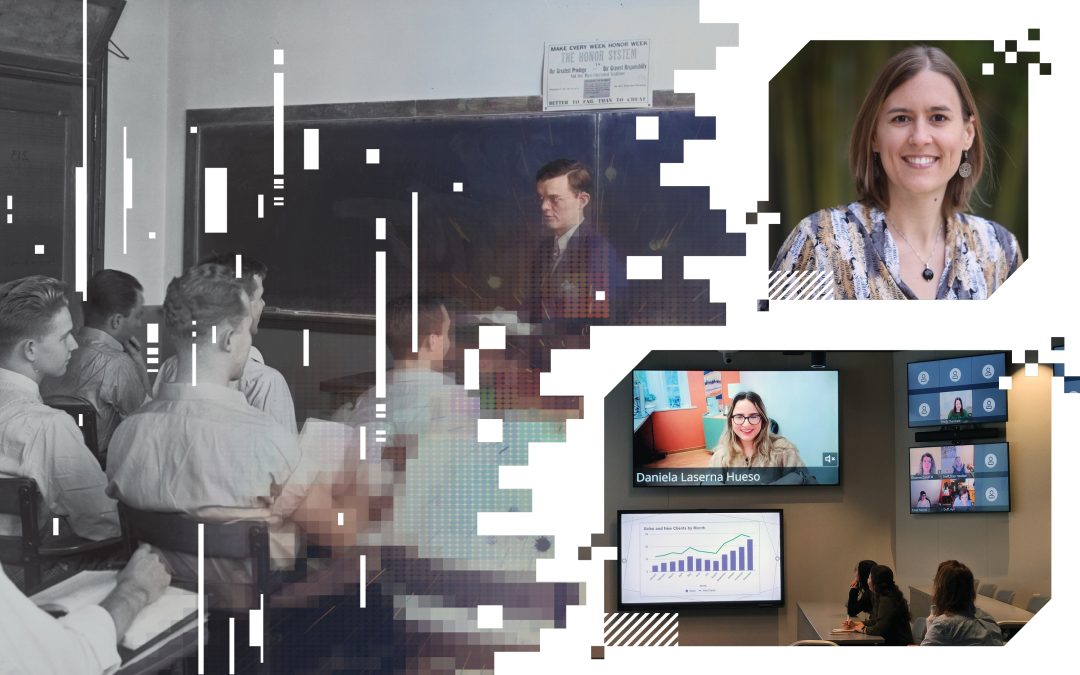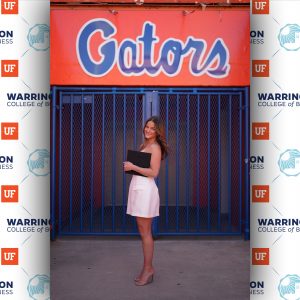The future of business education
How Warrington is at the forefront of advancements in education
Many naysayers claim the future of education is bleak. They say academia is fraught with archaic attitudes, policies of old, and close-minded professors clinging to the ivory tower. That future is bleak. Luckily, it’s not ours.
College students today have oodles more decisions than I did at the turn of the 21st century when I graduated high school in rural Georgia. We had to figure out this new thing called a cellphone while we celebrated our newly hard-wired internet that was lightning faster than the dial-up we had at home.
Now, education is hyper-mobilized through technology in a way that I never would have envisioned. AI proliferates all of our conversations, makes many of us excited about the future, and—let’s be honest—a large quantity of us anxious about the future of education. The classroom is in the process of being redefined, and the cloud is our anchor. Think about the irony of that statement for a minute.
But education evolves through and with innovation. It always has. And innovation thrives in the midst of conflict. All great ideas often start from someone who is uncomfortable where they are and wants to solve a problem. In that sense, the future of education is about to become more exciting than anything we might have ever seen. We all claim we want to be flexible and adaptable. Now is our chance to prove it.
The future of education is skills-based.
From an administrator’s perspective, the day-to-day tasks of education can sometimes feel like solving an ever-changing Rubik’s cube. Every time we come up with a new course, we have to jostle around curriculum requirements to fit it in, figure out how to design it, and find a faculty to teach it. As fast as technology is changing, we are going to have to work harder and collaborate more frequently to figure out how to match courses to ever-changing workforce skills.
Warrington has always had a leg up in this space. We’ve consistently prepared our students for the workforce through many technology revolutions before. Years ago, we moved most exams from paper to online to ask students to use Excel rather than a hand calculator because very few professionals were using a physical calculator in the office anymore.
As we think about making similar curriculum pivots today, we are embracing AI by considering how we teach students to write prompts, discern and edit AI drafts, and determine where the ethical line is to use AI responsibly. We are also pondering what types of critical thinking will be needed in a world full of average answers from an AI copy and paste.
As much as AI is touted as a solution for scaling classes and decreasing instructor workload, I find that teaching students how to interact and use AI responsibly is a trade of workload hours, not a reduction. Instead of worrying about writing multiple choice questions (which AI can do easily), I spend more time interacting with student writing, giving feedback, and showing students how to distinguish themselves beyond the likes of a ChatGPT answer. That need for critical thinking, student mentorship and deep learning is only going to grow.
Our biggest task in the coming years will be defining what skills our future workforce will need and designing a flexible curriculum around those skills. We will need to continue micro-credentialing, experiential learning, and technology certification. Ideally, we’d add even more soft skills, too—design, critical thinking, problem-solving, and creativity. We can no longer assume students acquire those soft skills in the periphery of their general education.
We’ve started an amazing foundation here at Warrington of skill-stacking. We offer undergrads a newly revised curriculum to level up their career readiness. They acquire multiple competencies through Gator Ready and see their HireWarrington account from the minute they start as a freshman to start plotting their desired skillsets and career paths. Graduate students have opportunities for international trips that increase their global perspective in the workplace, tailored workshops that focus on areas of interest, and practicums that partner with corporations to find workplace solutions. Combined with coursework, all of these programs stack skill after skill to give our students the best foundation to launch their careers.
As good as that start is, we still need to continue to be forward-thinking. We will need to be risk takers, and we’ll need to be stacking on our own skills to better prepare our students. The future of education at Warrington will only be transformative if we—as administrators, faculty, alums and donors—decide to remain on the front lines of innovation at a pace like never before.
The future of education requires new, focused perspectives.
As an academic body, we are often too quick to think that what we have always done and how we have always done it will continue to be a formula for success. While we read books about how to create new habits, consider organizational change, or empower our ways of thinking—rarely do these bold ideas make their way down the pipeline to true transformation. Perhaps one roadblock is our habit of thinking that an experience has to be 100% different to be transformational. We want to pivot from chalkboards to virtual reality, robot teachers, and holograms.
But maybe the math isn’t that exponential. Have you ever seen a video of a makeover? A human with a different haircut can look like an entirely different person. But that human is still 98% the same, even with the new do. Education can be the same. We can make small changes that have transformational outcomes for our students.
Classroom Makeover
Our most recent classroom makeover is the new dual modality classroom in Stuzin Hall 102. In the fall of 2023, Warrington launched an initiative to take an older lecture hall and renovate it into a dual modality classroom. We wanted a room that met the tech-forward needs of the 21st century student and the focused needs of faculty who simply want to teach. We needed a big idea that solved the obvious but pervasive problems of hybrid learning. We started with a perspective shift, added in some new technology, and were brave enough to change tradition.
In spring 2025, students will be able to choose if they take classes synchronously online or if they come to campus. Both audiences will get high quality recordings, interactive whiteboards, movie quality video and choices in which part of the room they want to see in the online space. Faculty will teach. No microphone needed, no switching screens, no need to even talk in your teacher voice to be heard in the online space. Directional, high-quality audio will alert the instructor to where students are. Students can present in class or online with the same experience, tools and audience. We will come close to achieving equality of experience with students in differing locations.
The biggest perspective shift in that room? The traditional teaching lectern is not at the center of the room. Shocking, I know. To encourage interaction, we moved the biggest physical barrier between students and instructors and relocated the instructor desk to a corner. Additionally, we loaded the room with mobile teaching ability. You can run a class from an iPad, annotate on a digital whiteboard, or rely on a director to navigate while you teach. The classroom got a makeover, but the biggest change was a change in tradition: the instructor no longer stands behind a lectern in the front of the room.
But our classroom is still a physical room. It still requires an instructor and students. We have not moved to a fully digital twin experience. A simple shift in perspective, based around what actual problems need solving, can be transformational.
Course Content Makeover
Our second recent makeover comes in the form of an ongoing change to undergraduate core course content. Don’t worry, we are still teaching accounting, finance, management and marketing, but we are actively reevaluating the day-to-day learning material that we expect 21st century students to consume.
Universities work on a schedule. Our best schedule lends itself to two-hour classes in a room. These class sessions can be remarkable; as many of you know, rich discussions can take an hour to really get going. However, with some of our introductory courses, two hours of instruction is a long haul. To help, we worked with faculty to record the key concepts of their lectures in the studio, saving more time in the class for problem sets, practice, and application. This small shift focused more classroom time on applied learning, but also helped students who wanted to review content before exams without having to sift through a two-hour long classroom video. Most faculty still spend the same amount of time in the classroom; students need a lot of practice to master finance concepts. But those students now have the luxury of in-person class time coupled with high-quality 8–10 minute videos to watch ahead or go back to review.
In addition to prerecorded content, we also picked the most complicated concepts to animate. These animations are engaging and provide immediate retention by layering auditory learning with visual learning. You can learn more about these animations on page 36 of this magazine.
At the end of the day, the extra practice and review combined with layered, illustrative learning gives students a better chance at succeeding in a rigorous course.
Learning Outcome Makeover
We are also revisiting our learning outcomes, which are the promises we make to students about what they will get out of each course. As a business college, we define and defend learning outcomes in partnership with faculty and use those outcomes to measure student progress and show improvement for the accreditation process.
Most learning outcomes change only slightly every 5–10 years. Any student needs to learn to how to write persuasively in a business communication course, and every finance student needs to learn time value of money. But if we are to stay in our forward thinking space, what do we now need to add? Changing learning outcomes for degree programs is not easy, but the effort is important. UF is the AI university and we have AI across the curriculum, so we must address how each course and program will integrate AI. To figure out this new Rubik’s cube, we’ll have to rely on our outstanding research faculty to give us their best prediction for the future workforce. We’ll need our alumni and advisors to tell us what is changing in their corporate spaces. And we’ll need our students to report back from their internships and interviews. Authentic collaboration to succeed at this process will take a village if we want to make it valuable, which leads me to my most important point.
The future of education will firmly rely on authenticity, community and close connection.
When people hear “the world is changing…” they often imbue that phrase with an ominous tone and some even cue their brain to hit play on a 1980s horror movie music track. Somehow every generation ends up breaking boundaries, moving the human race forward, and then being fearful of the next upcoming change.
From my point of view, “the world is changing!” (said with excitement). We have so much opportunity to do so much good, particularly in regards to education. I’m not saying we don’t have a lot of problems to wrestle with, but we have opportunities that are a thousand times easier to pull off. We can offer students better ways to study, give them real-world practice rather than just book knowledge, create fully inclusive learning environments, empower them with problem-solving skills combined with technology, and teach them how to power-up their processes with ethical use of AI.
But every one of those hopes and excitements sits atop our ability to remain authentic, empathetic, and connected as a community. In the Teaching & Learning Center, we love technology, but we love teaching more. Using shiny new tools is only useful after we establish connection with our students (and a purpose for the tool). We cannot ask students to be ready to learn without also making ourselves ready to teach. Both sides of that equation are going to take more effort.
As such, we must recommit to creating community in the classroom. Let’s be real—much of the fear around AI comes from recognition that AI is better than us at many things, that AI might become more human than we’d like. That fear, plus screens, avatars, and black Zoom boxes will make creating community a challenge. But group interactions showcase the authenticity of community that is lacking in AI. So one-on-one, peer-to-peer, and group-to-group interaction must be a non-negotiable tenet around the future of education.
As we face-off against screens, distractions and auto-generated content, the future of education relies on human connection. We will need new perspectives and skills, but we will need each other more.




